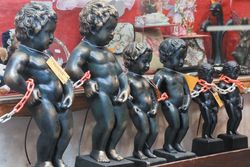Ian Buruma in The New York Review of Books:
 Brussels has frequently had a bad press. Already in the 1860s, Baudelaire, who fled there from the French censors, called the Belgian capital “a ghost town, a mummy of a town, it smells of death, the Middle Ages, and tombs.” To a growing number of Europeans, “Brussels” is a byword for bureaucratic bullying by the so-called Eurocrats. Donald Trump called Brussels a “hellhole.” Perhaps he was thinking, if that is the right word, of Molenbeek. Densely populated by immigrants, mostly from North Africa, this district has become a symbol of seething European jihadism. Last year’s mass murders in Paris were apparently plotted there; the number of young men and women (around a hundred) who have left Molenbeek to fight for ISIS in Syria and Iraq is relatively high.
Brussels has frequently had a bad press. Already in the 1860s, Baudelaire, who fled there from the French censors, called the Belgian capital “a ghost town, a mummy of a town, it smells of death, the Middle Ages, and tombs.” To a growing number of Europeans, “Brussels” is a byword for bureaucratic bullying by the so-called Eurocrats. Donald Trump called Brussels a “hellhole.” Perhaps he was thinking, if that is the right word, of Molenbeek. Densely populated by immigrants, mostly from North Africa, this district has become a symbol of seething European jihadism. Last year’s mass murders in Paris were apparently plotted there; the number of young men and women (around a hundred) who have left Molenbeek to fight for ISIS in Syria and Iraq is relatively high.
Still, much of the negative reputation of Brussels is undeserved and overblown. Brussels is not a dangerous city—not even Molenbeek, which is shabby, sullen (unemployment 30 percent), socially cut off, but not especially menacing. Many non-Muslim hipsters live there as well. Parts of Brussels are actually quite beautiful. The city has many fine examples of Art Nouveau and Art Deco, as well as the more famous sixteenth- and seventeenth-century gold-gabled buildings on the magnificent Grand Place. But Brussels is indeed rather chaotic, a political mess of nineteen different municipal districts, each with its own public authorities competing for funds, with an uncoordinated police force prone to conspicuous failures, and different political parties, linked to different language groups, operating their own more or less corrupt systems of patronage. Brussels, which has its own government, is mostly Francophone, but it is also the capital of Dutch-speaking Flanders and the capital of the European Union, whose own “Quartier Européen” is almost like a separate city within the city.
More here. (Note: Thanks to Asad Raza)
Ten years ago, an Irish pub owner was clearing land for a driveway when his digging exposed an unusually large flat stone. The stone obscured a dark gap underneath. He grabbed a flashlight to peer in.
